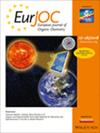Reactions of Halogermylenes with NHCs: Selective Formation of Low Valent Ge(II) Species
IF 2.5
3区 化学
Q2 CHEMISTRY, ORGANIC
引用次数: 0
Abstract
The reactions of the Rind‐based 1,2‐dihalodigermenes, (Eind)BrGe=GeBr(Eind) (1a) and (EMind)ClGe=GeCl(EMind) (1b), with two types of N‐heterocyclic carbenes (NHCs) (Im‐iPr2Me2 and Im‐Me4) resulted in the formation of the halogermylene mono‐NHC adducts, (Im‐iPr2Me2)(Eind)GeBr (2a') and (Im‐iPr2Me2)(EMind)GeCl (2b'), and the germyliumylidene cation bis‐NHC adducts, [(Im‐Me4)2(Eind)Ge]+[Br–] (3a) and [(Im‐Me4)2(EMind)Ge]+[Cl–] (3b). The resulting Ge(II) species are stabilized by the bulky Rind groups and the strongly σ‐donating NHC ligands, whose structures were confirmed by a single‐crystal X‐ray diffraction (SC‐XRD) analysis. Based on DFT and QTAIM calculations of 2a' and the cationic part of 3a, it was concluded that while the Ge–C(Eind) and Ge–C(NHC) bonds exhibit distinct differences in their degrees of polarization, all the Ge–C bonds display a partially polarized covalent character. Both reaction energy calculations and experimental studies suggested the potential liberation of an NHC ligand from the germyliumylidene cation bis‐NHC adducts, leading to the exchange of the NHC ligands. The formation mechanism of 3a from 1a and two NHC molecules via (Im‐Me4)(Eind)GeBr (2a) is discussed based on DFT calculations.求助全文
约1分钟内获得全文
求助全文
来源期刊
CiteScore
5.40
自引率
3.60%
发文量
752
审稿时长
1 months
期刊介绍:
The European Journal of Organic Chemistry (2019 ISI Impact Factor 2.889) publishes Full Papers, Communications, and Minireviews from the entire spectrum of synthetic organic, bioorganic and physical-organic chemistry. It is published on behalf of Chemistry Europe, an association of 16 European chemical societies.
The following journals have been merged to form two leading journals, the European Journal of Organic Chemistry and the European Journal of Inorganic Chemistry:
Liebigs Annalen
Bulletin des Sociétés Chimiques Belges
Bulletin de la Société Chimique de France
Gazzetta Chimica Italiana
Recueil des Travaux Chimiques des Pays-Bas
Anales de Química
Chimika Chronika
Revista Portuguesa de Química
ACH—Models in Chemistry
Polish Journal of Chemistry.

 求助内容:
求助内容: 应助结果提醒方式:
应助结果提醒方式:


